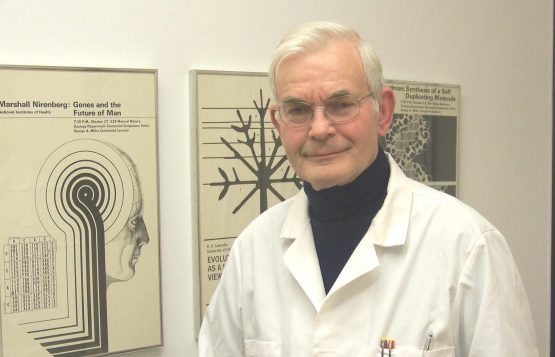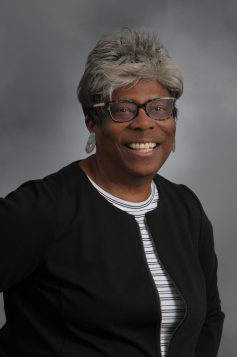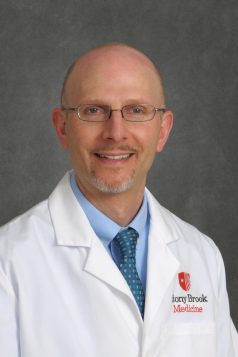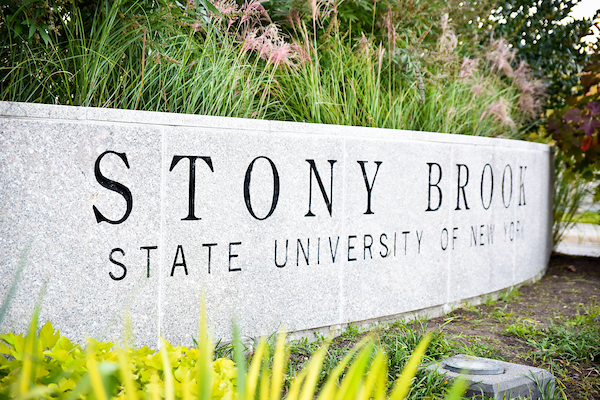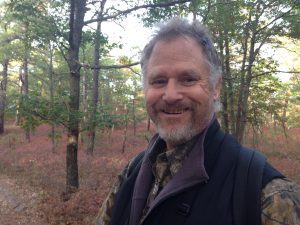By Daniel Dunaief
It’s back, bigger than ever, with an added Peter-and-the-Wolf style musical debut.
This year’s version of Science on Stage at Stony Brook University, which brings together the research and life experiences of three scientists with the artistic interpretation and creative talents of three playwrights, focuses on the theme of climate change.
Before the reading of the plays at the free October 28th event at the Staller Center’s Recital Hall, a group of eight high school students and two graduate students will perform an original piece of music composed by Professor Margaret Schedel called “Carnival of the Endangered Animals” (see accompanying story below).

The event, which has a seating capacity of 379, which is almost triple the potential audience size from last year, and requires advance registration, is sponsored by the Collaborative for the Earth (C4E).
The organizers of Science on Stage “want people to be thinking about [climate change] from new ways or with new perspectives,” said Heather Lynch, inaugural director of the C4E and Endowed Chair for Ecology and Evolution at Stony Brook’s Institute for Advanced Computational Science and Professor in the Department of Ecology and Evolution.
In these performances, professional actors, directed by Logan Vaughn, share a dramatic reading of the scripts, titled “Ghost Forest,” “Counterfactual,” and “Resplendence.” After the performance, the scientists and playwrights will participate in a question and answer session led by Lecturer J.D. Allen, who is managing editor of NPR affiliate WSHU.
Provost Carl Lejuez, whose office provides funding for the C4E, celebrated the ongoing collaboration between the humanities and the sciences.
“Science on Stage is one of our true interdisciplinary gems,” Lejuez explained. “In a time of such misinformation, the arts provide such a powerful vehicle to communicate science in accessible and inspiring ways.”
Indeed, in addition to hearing an original piece of music and listening to a reading of the plays, audience members will have the opportunity to share their perspectives on climate science before and after the performance.
Christine Gilbert, who holds a joint appointment at the School of Communication and Journalism and the School of Marine and Atmospheric Sciences and is one of the participating scientists, is conducting a study of the effect of the experience with audience members.
Attendees can participate in a short mobile-based survey before the plays and immediately afterwards. A social scientist, Gilbert will follow up with those members who are willing to engage in individual interviews in the weeks after the performance.
Event organizers wanted to know “what is it that’s so magical in the intersection between science, humanity and art” that drew a crowd so large last year that the fire marshal had to turn people away, said Gilbert.
By polling the audience, Gilbert, who was one of the people who couldn’t watch the show last year, hopes to explore the effect of teaching complex science in this forum.
She also hopes to assess how audience members feel after hearing more about climate change and plans to share what she learns with Stony Brook and with the broader scientific community through a published paper.
Heavy and humorous
The scientists and the playwrights appreciated the opportunity to learn from each other and to engage in a creative effort designed to use science, or the life of scientists, to appeal to audiences.
Lynch, who participated in the Science on Stage effort last year, suggested that this year’s plays are powerful and evocative.
“These are deep, adult serious issues,” she said, cautioning that the language includes some cursing and that the themes include loss, parenthood and grief. “This is not Disney.”
To be sure, the plays blend a wide range of emotions.
“With short plays that deal with heavier topics, playwrights will gravitate towards humor,” said Ken Weitzman, Founder and Associate Professor of Theater at Stony Brook, who started Science on Stage virtually in 2020. “It’s how we engage” and commune with an audience.
Counterfactual

Author of the play “The Agitators,” about a true narrative describing the 45-year friendship between suffragist Susan B. Anthony and abolitionist Frederick Douglass, Smart said he has taken long Uber rides with people whose views differ from his, leading to spirited conversations.
When Smart described his experiences to Reed, they discovered they had similar interactions.
While much of the script involves a combination of conversations and ideas, Smart explained that part of the dialogue in the play came from a discussion he and Reed had about food choices and climate change.
The interaction about cheeseburgers is “based on something [Reed] said to me,” Smart said. Reed explained the high carbon footprint of a cheeseburger, although he urged Smart to cut back rather than eliminate them from his diet.
“The play is about two people who see things very differently who choose to have a dialogue and to have a tough conversation,” said Smart. “They’re both affected by it.”
Ghost forest

Elizabeth Watson, Associate Professor in the Department of Ecology & Evolution, teamed up with Gab Reisman, who wrote “Ghost Forest.”
In this play, a climate researcher’s subjects spring to life as she writes an important grant proposal.
While it doesn’t reflect how field research or grant writing typically goes, it does capture “some things that have happened to me,” Watson said.
Her field work has involved considerable challenges, including getting stuck in the mud, being covered in ticks, crawling across mudflats, and being abandoned on a raft in a lagoon.
Watson appreciates how the artistic effort allows her to connect with people who probably aren’t the same ones who would read a publication she wrote or come to a presentation.
She also added that the world has what it needs to deal with climate change and that people need to understand the kinds of partnerships and actions that make a difference.
Resplendence

After speaking with Gilbert, playwright Kareem Fahmy wrote “Resplendence,” which follows three generations of a family who try to save their island off the coast of Maine.
The New England State is an important setting for playwright and scientist.
“Maine has such a special place in my heart,” said Gilbert, who has family in the state and attended college at the University of Maine. The pull of the “wild, eastern coast of Maine is so ubiquitous.”
Gilbert appreciated how Fahmy did a “great job of personalizing the context” of the state.
The challenge of preserving destinations, particularly those close to sea level, will likely persist.
“When you do any research about climate change, you have to be aware that this is not just a problem for people living today, but for people 200 years from now,” Gilbert said.
Weitzman said the play was an epic despite its short running time and thought it was “quite touching.”
Beyond the performance
Weitzman suggested that the plays can provide an educational component beyond the confines of the Staller Recital Hall.
While people can’t produce the plays as part of paid entertainment, teachers can read and use them in the classroom. Actors Bill Heck, April Matthis, Tina Benko, Mandi Masden and Taylor Crousore will provide dramatic reading of the plays.
In a short time, the actors are “practically off the book,” as they embrace the opportunity to bring the words to life, Weitzman said.
He suggested the plays offer a glimpse into researchers’ lives. “Here is this person on the front lines. I’m surprised at the angles that are taken” in these plays.
Stony Brook University’s Staller Center for the Arts, 100 Nicolls Road, Stony Brook will present this year’s Science on Stage: Climate Edition on Monday, Oct. 28 at 4 p.m. Doors open at 3:30 p.m. The event is free and open to the public but reservations are strongly recommended.
To register, go to: https://bit.ly/4dcDtsi or click here.
—————————————-
SBU’s Margaret Schedel brings endangered species to life through musi

Science on Stage at Stony Brook University added a new dimension to the performance this year, as Margaret Schedel, Associate Professor of Music, composed “Carnival of the Endangered Animals.” The original music, which will debut on Oct. 28 at 4 p.m. at the Staller Center’s Recital Hall, is a recreation of the sounds of a wide range of animals who are in danger of becoming extinct.
“It’s melodic, interrupted by moments of trying to translate” the calls from these animals, Schedel said.
Ken Weitzman, Founder and Associate Professor at Stony Brook, appreciates how quickly music can resonate for audiences.
“Music appeals to the emotions,” said Weitzman. “I’m jealous of how quickly music can do in 10 seconds what it takes me hours to do.”
The animals featured in the piece, along with the instrument that captures their sounds, are: the Atlantic Right Whale (Marimba); the A’kikiki bird, which is a Hawaiian honeycreeper (flute); Sumatran Tiger (trumpet); sage grouse (clarinet); Bajii, which is a Yangtze river dolphin; and the Jiangtun, which is a Yangtze finless porpoise (four-hand piano); gorilla (french horn); African bush elephant (trombone); Koala (bassoon); and the penguin (oboe).
Schedel plans to share information about each piece, which eight area high school students and two graduate students will perform, with the audience through a QR code, so they can connect the sounds with the message or visuals she was conveying.
Schedel tried to use a logical progression of the instruments, mixing up the woodwinds, percussion and brass.
Threatened by land development, the sage grouse includes high and low notes from the clarinet that gets covered up by the sounds of a flute and trumpet, imitating the sounds excavators make when they back up and develop McMansions.
Endangered by the spread of avian malaria carried by mosquitoes, the Hawaiian A’kikiki bird had been able to evade these insects by traveling higher up the mountain, where the colder temperatures kills the mosquitoes. That is not happening as much because global warming is enabling the blood sucking creatures to survive at higher elevation.
The sage grouse music starts with a melodic theme on the flute and as it goes higher, the theme becomes compressed. The buzzing brass, meanwhile, gets louder and louder as the mosquito pursues its meal, infecting the bird with a lethal parasite.
Reflecting the struggle for survival these creatures face, the Yangtze river dolphin, which had about 20 members when Schedel first started composing the music, may have become extinct by the time of the performance. That is, in part, why she combined the dolphin and the finless porpoise on the four hand piano.
As for the sounds of the elephant, Schedel recalled a safari she had experienced when she had been in South Africa. Elephants charged at Schedel and her group, who had come too close to the younger ones in the herd.
The elephants growled at Schedel and her companions.
“You can feel it in your chest, the sound waves moving,” she said. “Little by little, the younger ones put up their trunks and eventually a big momma elephant with a broken tusk put up her trunk, which is a symbol of, “we are calm,’” she said. With the trombone representing the elephant, the bass drum connotes its growling sounds.
When she was growing up, Schedel listened to the Leonard Bernstein version of “Peter and the Wolf” so many times that the recording is “nearly dead,” she laughed. She hopes people enjoy her piece with the same energy and excitement, connecting the sounds and the stories with the endangered animals.
Schedel described the experience of creating the music as a “labor of love.”


